#Yaroslavl governorate
Text

Abbess Taisia on the veranda,Leushinsky Saint John the Baptist Monastery,Yaroslavl governorate (1909)
Photography by Sergey Prokudin-Gorskiy (1863-1944)
#Россия#Russia#vintage#photography#Ярославская губерния#Yaroslavl governorate#russian#Христианство#Christianity#Сергей Прокудин-Горский#Sergey Prokudin-Gorskiy#русский фотограф#russian photographer#photographer#autochrome#vintage photography#1900s#1909#20th century
13 notes
·
View notes
Text



Drone attacks on RuZZian oil and Gas infrastructure - #PlanB ,
after western interventions on curtailing RuZZia’s daily revenue to fund the illegal and murderous war.
Context: Targeting the interruption of this revenue by the EU and G7 countries have until now - acted through implementation of sanctions and the oil price cap on seaborne russian oil.
The price cap has become ineffective, as RuZZia has moved from a 90% reliance on EU owned and insured oil tankers -
to an opaque and nefarious shadow fleet of tankers to shift it’s oil -
and is realizing a sale value well above the price cap -
which means more money to fund the war in Ukraine.
In the absence of the United Nations intervening in the growth of the shadow fleet of dangerous, aged and uninsured vessels shifting RuZZian oil,
and in the absence of the enforcement of the price cap.
This is through the EU and G7’s failure to implement secondary sanctions on shadow companies and shippers, who easily manipulate the cost of cargo born by the vessels using miscellaneous transport costs by the shadow carriers and intermediaries and oil traders.
Traders have a new lawless hotspot - based in Dubai.
The United Nations under the incompetent leadership of Antonia Guterres (currently playing the Palestine card while the World edges towards all out war),
Ukraine has implemented plan B -
a new tactic to circumvent RuZZia’s oil and gas supplies and revenue -
by using targeted #drone strikes on critical infrastructure.
Recent Drone Strikes:
RuZZia energy infrastructure has been hit by 7 drone attacks and fires in the past month, adding to uncertainty in global oil and gas markets already rocked by the conflict in the Middle East.
* on Jan. 18
that Ukraine had tried and failed to target a RuZZian Baltic Sea oil terminal with a drone.
Ukraine said it had hit targets in St Petersburg with domestic-made drone. Mikhail Skigin, a co-owner of the St #Petersburg Oil Terminal, told RBC media that the air defence had thwarted a "monstrous catastrophe", opens new tab, which could lead to human losses and ecological damage to the Baltic Sea.
* on Jan. 19
Four oil tanks at a large storage facility in the town of Klintsy in RuZZia's western Bryansk region caught fire after the military brought down a Ukrainian strike drone, the regional governor said.
* on Jan 19
A fire tore through Ryazan oil refinery, RuZZia's third-largest,,
* on Jan. 21
RuZZian energy giant #Novatek, was forced to suspend some operations at the huge Baltic Sea fuel export terminal at Ust-luga as well as "technological processes" at a nearby fuel-producing complex due to a fire, started by what Ukrainian media said was a drone attack. RuZZia will likely cut exports of naphtha by some 127,500-136,000 barrels per day, or around a third of its total exports, after fires disrupted operations at refineries according to traders and LSEG ship-tracking data.
* on Jan. 26
Rosneft's Tuapse oil refinery 250km inside RuZZia from the frontline - halted oil processing and output following a fire.
* on Jan. 27
#Lukoil halted a unit at NORSI, RuZZia's fourth largest refinery, located near the city of Nizhny #Novgorod, some 430 km (270 miles) east of Moscow, after an "incident".
RuZZian Deputy Prime Minister Alexander Novak said that repair work would take at least a month or a month and a half.
* Jan. 29
RuZZian air defences thwarted a drone attack on the Slavneft #YANOS oil refinery in the city of Yaroslavl, northeast of Moscow, regional governor Mikhail Yevrayev said.
* on Saturday, Feb. 3
Two Ukrainian attack drones struck the largest 300,000 bpd oil refinery owned by LUKOIL in the country's south, in Volgograd, the latest in a series of long-range attacks on RuZZian oil facilities which has reduced RuZZia's exports of naphtha, a petrochemical feedstock.
0 notes
Text
Saints&Reading: Thursday, February 22, 2024
february 9_february 22
THE HOLY MARTYR NICEPHOROS OF ANTIOCH (ca 257)
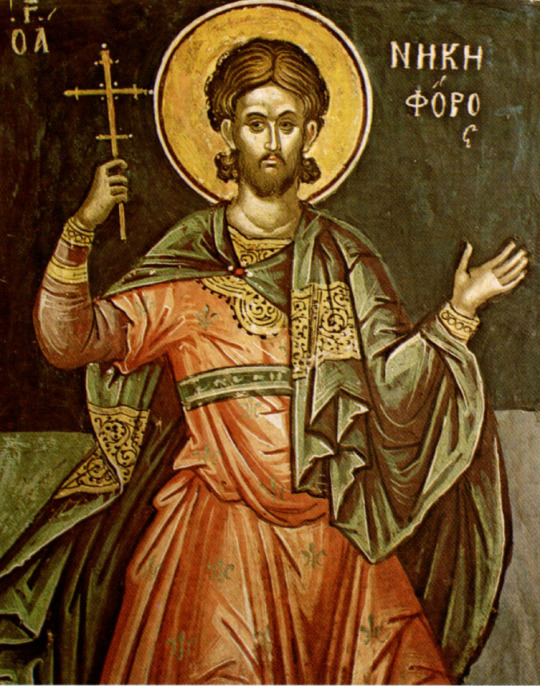
The Holy Martyr Nicephoros (Nikēphóros) lived in the city of Syrian Antioch, as well as presbyter Sapricius, with whom Nikephoros was so close that they were considered brothers. One day they quarreled because of some disagreement, and their former friendship changed into enmity and hate.
After a certain time Nikephoros came to his senses, repented of his sin and more than once asked Sapricius, through mutual friends, to forgive him. Sapricius, however, did not wish to forgive him. Nikephoros then went to his former friend and fervently asked forgiveness, but Sapricius was adamant.
At this time the emperors Valerian (253-259) and Gallius (260-268) began to persecute Christians, and one of the first brought before the court was the priest Sapricius. He firmly confessed himself a Christian, underwent tortures for his faith and was condemned to death by beheading with a sword. As they led Sapricius to execution, Nikephoros tearfully implored his forgiveness saying, “O martyr of Christ, forgive me if I have sinned against you in any way.”
The priest Sapricius remained stubborn, and even as he approached death he refused to forgive his fellow Christian. Seeing the hardness of his heart, the Lord withdrew His blessing from Sapricius, and would not let him receive the crown of martyrdom. At the last moment, he suddenly became afraid of death and agreed to offer sacrifice to idols. In vain did Saint Nikephoros urge Sapricius not to lose his reward through apostasy, since he already stood on the threshold of the heavenly Kingdom.
Saint Nikephoros then said to the executioner, “I am a Christian, and I believe in our Lord Jesus Christ. Execute me in place of Sapricius.” The executioners reported this to the governor. He decided to free Sapricius, and to behead Nikephoros in his place. Thus did Saint Nikephoros inherit the Kingdom and receive a martyr’s crown.
SAINT INNOCENT, BISHOP OF IRKUTSK (1731)
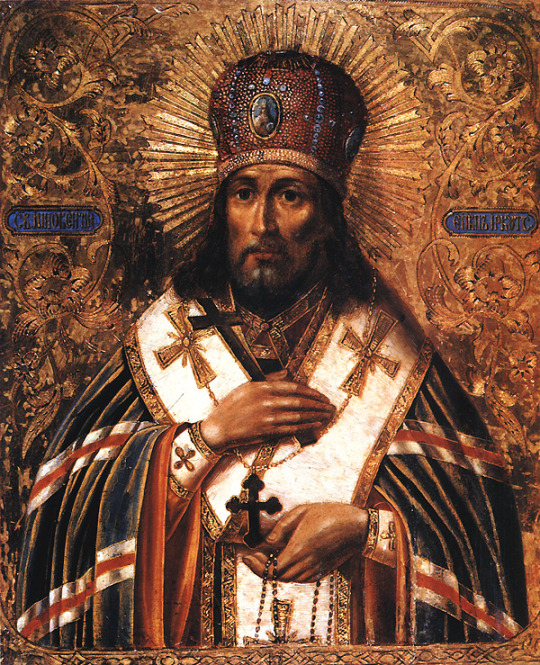
Saint Innocent, the first Bishop of Irkutsk, reposed on November 27, 1731. But because the Kursk Root Icon of the Mother of God is commemorated on that day, his Feast Day is celebrated on November 26.
After the Saint's death, his persecutors received their just retribution. Archimandrite Anthony was discredited in Beijing as unorthodox. He was returned to St. Petersburg, deposed and imprisoned. Soon afterward, the Vice-Governor of Irkutsk was executed for his crimes.
In 1764, the body of Saint Innocent was discovered to be incorrupt during restoration work on the Ascension Monastery’s Tikhvin church. Many miracles occurred not only at Irkutsk, but also in the remote places of Siberia, for those who turned to the Saint in prayer.
In 1783, there was a great fire at Ascension Monastery. Everything that could burn was burnt. However, the old wooden temple, where the Saint's body rested, remained unharmed.
On February 9, 1805, the Most Holy Synod decided to uncover the Hierarch's relics and to number him among the Saints.
On February 2, 1831, the Feast of the Meeting of the Lord, His Grace Bishop Benjamin took Vladyka's holy relics from his tomb and placed them in the midst of the Tikhvin church, and then he served the Divine Liturgy before them. A week later, on February 9, the Hierarch's relics were solemnly transferred from the Tikhvin church to the Ascension Cathedral in a Cross Procession with the wonderworking Kazan Icon of the Mother of God.
In the twenties of the XX century, a period of persecution by the new godless authorities against Christians began. The Superior of Ascension Monastery was arrested, along with other hierarchs of Siberia. In 1921, the Saint's relics were subjected to a sacrilegious medical examination, after which they were taken from the orphaned Monastery, and then they disappeared for a long time.
In 1990, in one of the churches of the city of Yaroslavl, Saint Innocent's relics were discovered in a utility room. A medical examination showed that the body, which was not touched by decay, was that of Saint Innocent. His holy relics were returned to Irkutsk, and today they rest in Znamensky Monastery.
Saint Innocent, the first Bishop of Irkutsk is commemorated on November 26 (the day of his repose), February 9 (the discovery of his relics in 1805), June 10 (Synaxis of the Saints of Siberia), September 2 (the return of his relics to Irkutsk in 1990), on October 10 (Synaxis of the Saints of Volhynia), and on the third Sunday after Pentecost (Synaxis of the Saints of St. Petersburg).
Source: Orthodox Church in America_OCA
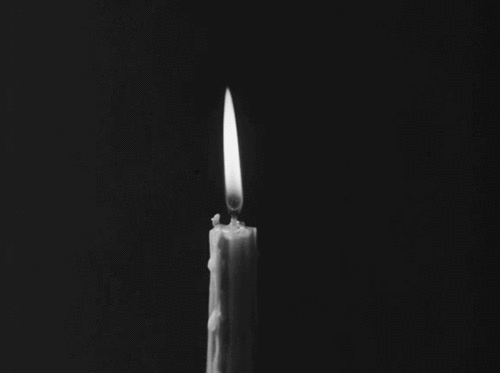
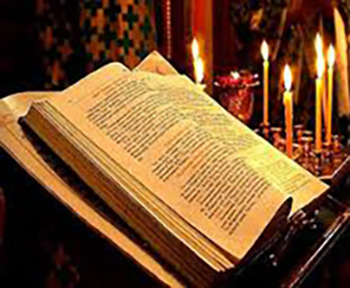
1 PETER 4:12-5:5
12 Beloved, do not think it strange concerning the fiery trial which is to try you, as though some strange thing happened to you; 13 but rejoice to the extent that you partake of Christ's sufferings, that when His glory is revealed, you may also be glad with exceeding joy. 14 If you are reproached for the name of Christ, blessed are you, for the Spirit of glory and of God rests upon you. On their part He is blasphemed, but on your part He is glorified. 15 But let none of you suffer as a murderer, a thief, an evildoer, or as a busybody in other people's matters. 16 Yet if anyone suffers as a Christian, let him not be ashamed, but let him glorify God in this matter. 17 For the time has come for judgment to begin at the house of God; and if it begins with us first, what will be the end of those who do not obey the gospel of God? 18 Now "If the righteous one is scarcely saved, Where will the ungodly and the sinner appear?" 19 Therefore let those who suffer according to the will of God commit their souls to Him in doing good, as to a faithful Creator.
1 The elders who are among you I exhort, I who am a fellow elder and a witness of the sufferings of Christ, and also a partaker of the glory that will be revealed: 2 Shepherd the flock of God which is among you, serving as overseers, not by compulsion but willingly, not for dishonest gain but eagerly; 3 nor as being lords over those entrusted to you, but being examples to the flock; 4 and when the Chief Shepherd appears, you will receive the crown of glory that does not fade away. 5 Likewise you younger people, submit yourselves to your elders. Yes, all of you be submissive to one another, and be clothed with humility, for "God resists the proud, But gives grace to the humble."
MARK 12:38-44
38 Then He said to them in His teaching, "Beware of the scribes, who desire to go around in long robes, love greetings in the marketplaces, 39 the best seats in the synagogues, and the best places at feasts, 40 who devour widows' houses, and for a pretense make long prayers. These will receive greater condemnation. 41 Now Jesus sat opposite the treasury and saw how the people put money into the treasury. And many who were rich put in much. 42 Then one poor widow came and threw in two mites, which make a quadrans. 43 So He called His disciples to Himself and said to them, "Assuredly, I say to you that this poor widow has put in more than all those who have given to the treasury; 44 for they all put in out of their abundance, but she out of her poverty put in all that she had, her whole livelihood.
#orthodoxy#orthodoxchristianity#easternorthodoxchurch#originofchristianity#spirituality#holyscriptures#bible#gospel#wisdom#saints
1 note
·
View note
Photo
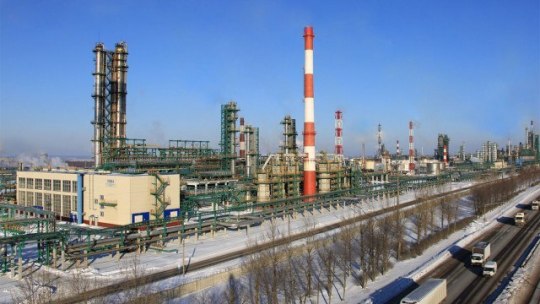
Drone Strike Targets Oil Refinery in Central Russia’s Yaroslavl Region
An attempted drone strike against an oil refinery deep within Russia was thwarted on Monday morning, according to regional authorities.
“The Slavneft-Yanos refinery’s electronic warfare system prevented a drone attack,” Yaroslavl region Governor Mikhail Yevrayev wrote on the messaging app Telegram.
Read more | Subscribe to our channel
0 notes
Text
Russian governor claims attempted drone attack on oil refinery in Yaroslavl
A drone attempted to attack one of Russia’s largest oil refineries located in Yaroslavl and was suppressed by electronic warfare, Mikhail Yevrayev, the regional governor, reported on Jan. 29. Multiple Source : kyivindependent.com/russian-g…

0 notes
Text
This weekend, as Russian soldiers were fleeing Ukraine’s Kharkiv region, many of their compatriots were going to the polls to vote for governors, regional parliamentarians, and municipal deputies. Though September 11 was Russia’s official “single voting day,” residents of some regions could cast their ballots as early as Friday. Not for the first time, this year’s elections were rife with reported violations and brought few surprises, at least according to available preliminary results. Meduza gives a rundown of what happened in Russia’s first elections since the Kremlin launched its full-scale war in Ukraine.
Russia’s three-day voting period, which saw elections in 82 regions between September 9 and September 11, has come to a close. Voters were given either one, two, or three days to cast their ballots, depending on the region where they live. Overall, more than 4,700 local and regional elections were held throughout the country. 14 regions had direct gubernatorial elections (and legislative assembly deputies in Adygea voted to reelect Murat Kumpilov as head of the republic). Six regions elected regional parliamentary deputies. In Moscow, the only place in the country where jailed opposition politician Alexey Navalny’s team held its “Smart Vote” initiative this year, municipal deputy elections were held in 216 of the city’s 245 districts.
In eight regions, including the city of Moscow, residents could vote online. According to the Russian Central Election Commission, both the Moscow and federal remote electronic voting (DEG) systems were hit by cyberattacks. Moscow election observers reported the attacks on the morning of September 9; by the afternoon, voters were unable to receive ballots. According to the independent election monitoring movement Golos, the failure lasted about 90 minutes. A total of 10,000 attacks were reported in Moscow over the three-day voting period, while Central Election Commission head Ella Pamfilova reported over 300 attacks on September 10–11 in Russia’s other regions.
According to Moscow Deputy Election Commissioner Dmitry Reut, turnout for Moscow’s municipal elections was at 32.8 percent as of 6:00 pm Moscow time on September 11.Reut reported that about 1.7 million people voted electronically, while over 645,000 people voted in person. In seven regions that also allowed electronic voting, according to Ella Pamfilova, almost 93,000 people had voted as of 4:30 pm on September 11. The Yaroslavl region had the highest turnout: by the morning of September 11, 83.5 percent of people registered to vote electronically had done so.
In all regions that held gubernatorial elections, according to preliminary data from Russia’s Central Election Commission, incumbent candidates are leading.
Election observers, candidates for office, and voters were all subjected to psychological pressure, according to Golos, which monitored elections in 19 regions. Election observers and members of candidates’ campaign teams were prohibited from taking photos or videos in polling places. Observers were also removed from polling places, threatened by law enforcement (and others), and arrested. In Moscow, multiple election observers were assaulted. By 3:00 pm on September 11, according to the human rights media project OVD-Info, 19 people had been arrested in connection with elections. Nine of them were candidates and five were observers.
According to Golos, more election violations were reported in the city of Moscow than in any other region; as of 7:00 pm Moscow time on September 11, 626 violations had been reported over the course of three days. The region with the second highest number of violations was Krasnodar Krai (168), followed by the Udmurt Republic (88), the Moscow region (80), and the Kirov region (67). Golos participants reported “anomalies” in voter turnout data, forced voting, and problems with remote voting. Some voters, including A Just Russia party leader Sergey Mironov, were unable to vote at their assigned polling places because they were already marked in the system as having voted electronically or because they were missing from voter registries.
Golos participants also told Meduza that they discovered a network of Telegram channels that were all created on August 22 specifically for the upcoming elections. The channels have repeatedly published false reports of election violations in Moscow polling places, allowing the Moscow City Election Commission to refute the reports.
Bulletins with small, pre-printed dots in the checkbox next to United Russia, the country’s ruling party, were found in Moscow, according to the news outlet Sota. A ballot box with a hole large enough to fit a hand through was seen in the Saratov region.
Russia’s Central Election Commission reported receiving 93 reports of possible election violations in the first two days of voting. Valery Fadeyev, the head of Russia's Presidential Human Rights Council, claimed that “the majority of election violation reports cannot be confirmed,” and that officials found only “tiny violations that can not possibly affect [election] outcomes.” Central Election Commission head Ella Pamfilova said on September 11 that “in terms of violations,” the weekend’s elections were “fairly boring,” Interfax reported. According to Pamfilova, 218 ballots in six regions were declared invalid. Russia’s Interior Ministry reported that it had not found any violations large enough to affect election results. Meanwhile, the ministry opened eight criminal cases.
0 notes
Photo

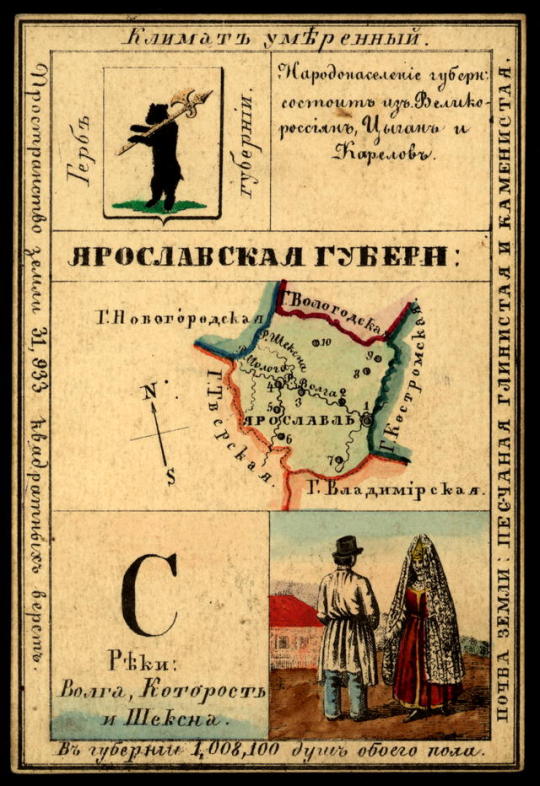






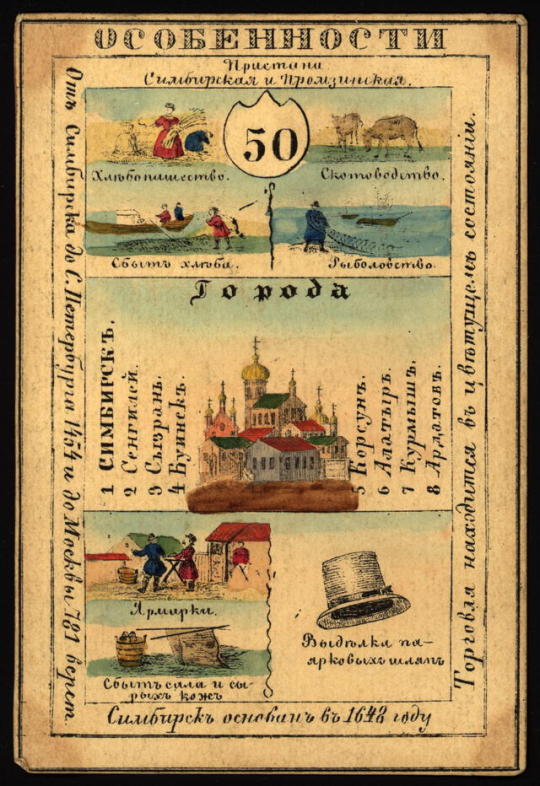

Illustrated cards for the provinces of the Russian Empire (published in St. Petersburg 1856). Each card presents an overview of the province's history, geography, culture and economics. The front depicts distinguishing features such as rivers, mountains, and major cities and industries. The back shows a map of the province, the provincial seal, information about the population, and a picture of the local dress of the inhabitants.
The cards shown here are the guberniyas (governorates) of Yaroslavl, Kostroma, Nizhny Novgorod, Kazan, and Simbirsk.
#history#art#geography#fashion#russia#yaroslavl governorate#kostroma governorate#nizhny novgorod governorate#kazan governorate#simbirsk governorate#yaroslavl#kostroma#nizhny novgorod#kazan#simbirsk#ulyanovsk
14 notes
·
View notes
Photo
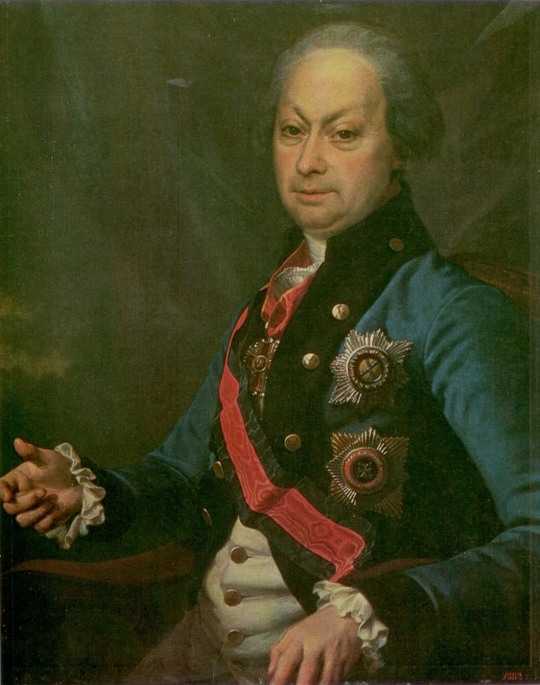
Melgunov, Alexei Petrovich, Governor-General Yaroslavl and Vologda, 1795, Dmitry Levitzky
Medium: oil,canvas
8 notes
·
View notes
Photo
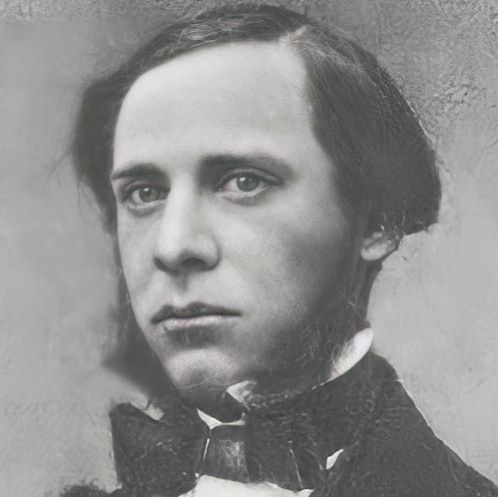
Mikhail Yevgrafovich Saltykov-Shchedrin[a] (Russian: Михаи́л Евгра́фович Салтыко́в-Щедри́н, IPA: [mʲɪxɐˈil jɪvˈɡrafəvʲɪtɕ səltɨˈkof ɕːɪˈdrʲin]; 27 January [O.S. 15 January] 1826 – 10 May [O.S. 28 April] 1889), was a major Russian writer and satirist of the 19th century. He spent most of his life working as a civil servant in various capacities. After the death of poet Nikolay Nekrasov he acted as editor of the well-known Russian magazine, Otechestvenniye Zapiski, until the government banned it in 1884. His best-known work, the novel The Golovlyov Family, appeared in 1880.Mikhail Saltykov was born on 27 January 1826 in the village of Spas-Ugol (modern-day Taldomsky District of the Moscow Oblast of Russia) as one of the eight children (five brothers and three sisters) in the large Russian noble family of Yevgraf Vasilievich Saltykov (1776—1851) and Olga Mikhaylovna Saltykova (née Zabelina) (1801—1874). His father belonged to an ancient Saltykov noble house that originated as one of the branches of the Morozov boyar family.[1] According to the Velvet Book, it was founded by Mikhail Ignatievich Morozov nicknamed Saltyk (from the Old Church Slavonic word "saltyk" meaning "one's own way/taste"[2]), the son of Ignaty Mikhailovich Morozov and a great-grandson of the founder of the dynasty Ivan Semyonovich Moroz who lived during the 14-15th centuries.[3] The Saltykov family also shared the Polish Sołtyk coat of arms.[4] It gave birth to many important political figures throughout history, including the tsaritsa of Russia Praskovia Saltykova and her daughter, the Empress of Russia Anna Ioannovna. Saltykov's mother was an heir to a rich Moscow merchant of the 1st level guild Mikhail Petrovich Zabelin whose ancestors belonged to the so-called trading peasants[5] and who was granted hereditary nobility for his handsome donation to the army needs in 1812; his wife Marfa Ivanovna Zabelina also came from wealthy Moscow merchants.[6][7] At the time of Mikhail Saltykov's birth, Yevgraf was fifty years old, while Olga was twenty five.[8] Mikhail spent his early years on his parents' large estate in Spasskoye on the border of the Tver and Yaroslavl governorates, in the Poshekhonye https://www.instagram.com/p/CTYsEGlMXhA/?utm_medium=tumblr
2 notes
·
View notes
Text
Icon, Saints&Reading: Sat, Sept., 3, 2021
September 7/ August 22
MARTYR EULALIA OF BARCELONA (303)
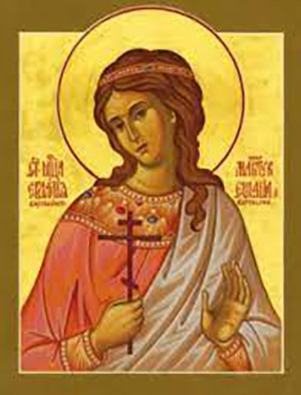
The Martyr Eulalia lived in Spain, near the city of Barcionum (now Barcelona), and she was raised by her parents in piety and the Christian Faith. Already at fourteen years of age, the maiden spent a solitary life in her parental home with others of her own age, occupied in prayer, the reading of Holy Scripture, and handicrafts.
During the time of a persecution against Christians under the emperors Diocletian (284-305) and Maximian (305-311), the governor Dacian arrived in the city of Barcionum to rid it of Christians. Hearing of this, the maiden secretly left her home at night, and by morning had made her way into the city. Pushing her way through the throng of people, the girl made a bold denunciation of the judge for forcing people to renounce the True God in order to offer sacrifice to devils instead.
Dacian gave orders to strip the girl and beat her with rods, but she steadfastly endured the torment and told the judge that the Lord would deliver her from the pain. They tied the martyr to a tree and tore her skin with iron claws, and they then burned her wounds with torches.
During her torment, Dacian asked the saint, “Where then is your God, Whom you have called upon?” She answered that the Lord was beside her, but that Dacian in his impurity could not see Him. During the saint’s prayer: “Behold, God helps me, and the Lord is the defender of my soul” (Ps. 53/54:4), the flames of the torches turned back upon the torturers, who fell to the ground.
The Martyr Eulalia began to pray that the Lord would take her to Heaven to Himself, and with this prayer she died. People saw a white dove come from her mouth and fly up to Heaven. Then a sudden snowstorm covered the martyr’s naked body like a white garment (the saint’s commemoration is sometimes given as December 10, which may be more correct, in view of the snow).
Three days later, the martyr’s parents came and wept before her hanging body, but they were also glad that their daughter would be numbered among the saints. When they took Saint Eulalia from the tree, one of the Christians, named Felix, said with tears of joy: “Lady Eulalia, you are the first of us to win the martyr’s crown!”
Saint Felix himself soon accepted death for Christ, and is also commemorated on this day.
ICON: Mother of God of Georgia
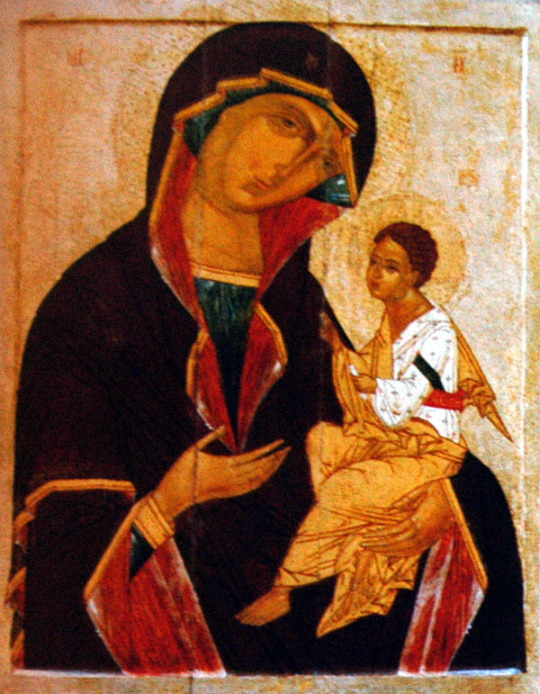
In 1622, the Persian Shah Abbas I, after the devastating invasion of Orthodox Georgia, took part of the Robe of the Lord, and some especially revered icons. Three years later, when the Russian clerk Stephen Lazarev, who was in Persia to do some trading, a certain person from the Shah's retinue offered to let him purchase one of the stolen Georgian icons: an icon of the Most Holy Theotokos. At the same time, at Yaroslavl, the merchant Gregory Lytkin, by whom Stephen was employed, had a revelation of his clerk's imminent arrival with the precious acquisition.
Lytkin had been instructed by a voice from above to take the Icon from Yaroslavl to Arkhangelsk, near the Pinega River. Here, 16 versts from Kholmogorsk, was the Black Mountain monastery (which took its name from the mountain, on which a church was built in 1603.) Later, it was called Krasnogorsk (Beautiful Mountain).
Here the merchant delivered the Georgian Icon of the Most Holy Theotokos in 1629, during the reign of Tsar Michael. On August 22, with a large contingent of the faithful, the Icon was reverently placed in the monastery. At the same time, the miraculous healing of the blind and deaf monk Pitirim took place. The subsequent manifestations of the Icon's miraculous power prompted Metropolitan Nikon of Novgorod (later the Patriarch of Moscow and All Russia) to investigate. Afterward, from 1650, the annual celebration of this Icon took place on August 22, the day of its arrival at Krasnogorsk Monastery.
From that time, the Georgian Icon of the Mother of God was brought to Arkhangelsk each year with honors. The revered Icon was left for a certain time in the main cathedral of the city, for the sanctification of the city and of the Christ-loving people. During the reign of Tsar Alexei (1645-1676), the miraculous Icon was taken to Vologda, Great Ustyug, Pereyaslavl-Zalessky, and Siberia.
In 1654, Hieromonk Makarios of Krasnogorsk Monastery brought the Icon of the Most Holy Theotokos (which had been brought from Persia) to Moscow for restoration, and to be covered with a new riza. It was placed in the newly-built church, dedicated to the Life-giving Trinity, at Nikitnikov Lane near the Saint Barbara Gate, where the Kremlin masters carried on their iconographic work. Gregory Nikitnikov had built the church on his property at his own expense (1628-1651). In the church was a chapel dedicated to Saint Nikḗtas (September 15). Members of the Nikitnikov family were also entombed there.
About that time, a plague or pestilence was raging in Moscow. At the request of the master silversmith Gabriel Evdokimov, whose son was near death, a Moleben was served in his house before the Georgian Icon of the Mother of God from Krasnogorsk Monastery. The patient soon recovered. In gratitude for this miraculous healing, a copy of Georgian Icon was made and placed in Holy Trinity church. From that time, the church was also called Georgian.
The gracious help of the Most Holy Theotokos continued to be conferred by the aforementioned copy of her Icon. During the plague epidemic of 1654, the Moscow merchant Stephanov prayed continuously to the Queen of Heaven. The Most Holy Virgin appeared to him three times in a dream saying: "Pray to the Georgian Theotokos, on the Glinishchi at the mills, and you will be spared." The Holy Trinity church at Nikitniki was also called the church of the Great Martyr Nikḗtas (one of the chapels) on Glinishchi, near the mills. The merchant did not take his family from Moscow as he intended, but began to pray fervently in the Holy Trinity church. The epidemic did not touch him or his family.
The Churchwide celebration of the Georgian Icon of the Mother of God was established with the blessing of Patriarch Nikon in 1654. In 1698, the caretaker of the Moscow printing house Theodore Polikarpov compiled a second edition of the Service.
After the liberation of Moscow from Napoleon's troops, on December 1, 1812 the wonderworking Georgian Icon of the Mother of God, along with other miraculous Icons of the Most Holy Theotokos (Vladimir, Iveron, and Assuage my Sorrows) were carried in solemn procession around the Kremlin.
In 1904, a chapel was built in Holy Trinity church in honor of the Georgian Icon of the Mother of God. Now this Icon is in the church of the Holy Trinity in Nikitnikov (Razin Street).
Miraculous healings were granted by the Most Holy Theotokos through her wonderworking Icon, which were documented and verified at the end of the XIX century. For example, on June 17, 1887, Lydia Tserkovnitskaya, the wife of a priest in the village of Shuysk, Vologda Province, was critically ill. She recovered after praying before the wonderworking Georgian Icon. There is historical evidence of four more Georgian icons of the Most Holy Theotokos.
Concerning the Georgian Icon of the Mother of God, which was in Moscow's Alekseevsky Convent, church evidence reports that it is not a copy of the Icons from Krasnogorsk Monastery nor from Holy Trinity church at Nikitnikov, which were brought from Georgia. In the same deadly plague epidemic of 1654, one of the nuns at the Alekseev Convent fell ill. While she addressed long prayers to the Heavenly Healer, the sick woman suddenly remembered the miraculous recovery she had heard about from the Icon of the Mother of God, which is in the church of the Life-giving Trinity by Saint Barbara's Gate. However, there was no one to send there. After some time, an unknown monk came to the Convent. Turning to the sick nun, he said: "Do not be sad that the Georgian Icon of the Mother of God cannot be brought here. You have here exactly the same Icon as the one brought from Georgia. You will find it in the cave, and you shall behold God's mercy."
The allegorical meaning of these words became clear afterward in the monastery sacristy, which was laid out like caves, when a hitherto unknown Icon of the Mother of God was discovered. After a Moleben, the miraculous Icon was carried to the cells of the nuns who were suffering from the pestilence. All of them were healed. From that time, the epidemic in Moscow began to abate.
Through the prayerful intercession of the Georgian Icon of the Most Holy Theotokos at the Alekseev Convent, the blind Princess Martha Prozorovskaya received miraculous healing in 1662. She gained her sight by the prayers of her parents, after seven years of serious illness.
To the northwest of Kazan, 18 versts from the city of Sviyazhsk, in the middle of the XVII century was the Raithu communal Hermitage of the Theotokos, which got its name from one of its churches, which was dedicated to the Venerable Fathers slain at Sinai and Raithu (January 14). Tradition states that during the construction of the monastery, Metropolitan Laurence of Kazan, by a revelation from above, sent the best local iconographers to Pinega, to the Krasnogorsk Monastery, which was very far from Kazan, in order to make a faithful copy of the wonderworking Icon of the Most Holy Theotokos, which was brought from Persia.
In 1661, a skillfully executed copy of the Georgian Icon of the Mother of God was delivered from Arkhangelsk. It became highly revered by the local population. Subsequently, this Icon was placed in the cathedral church in honor of the Most Holy Theotokos.
In the XVIII century, the pious peasants of the village of Klyucharev, Korchev county, Tver Province, presented the caretaker of the Moscow Archangel Cathedral with a copy of the Georgian Icon of the Mother of God, which became highly regarded by the locals, when the rye crop was threatened with destruction in the late 1860s. Vast fields of newly-sprouted crops were being eaten by an unknown worm, and nothing they did was of any use. Then the peasants prayed for help to the Most Holy Theotokos, whose Georgian Icon they revered. After a Cross Procession around the fields with the Icon, a sudden, unprecedented torrential rain fell. Streams of water washed the worms out of the ground, which were eaten by a large flock of birds. See also other revered copies of the Georgian Icon of the Mother of God in the Protection church at Vorontsov Field, and in the Holy Cross Church in the city of Tula.
The Icon disappeared after the closure of the monastery (1920-1922), and later it was returned to the monastery. In his 1946 report to the Moscow Patriarchate, Bishop Leonty (Smirnov) of Arkhangelsk states that the Georgian Icon was carried in a procession, which took place at Arkhangelsk in 1946. The further fate of the Georgian Icon is unknown.
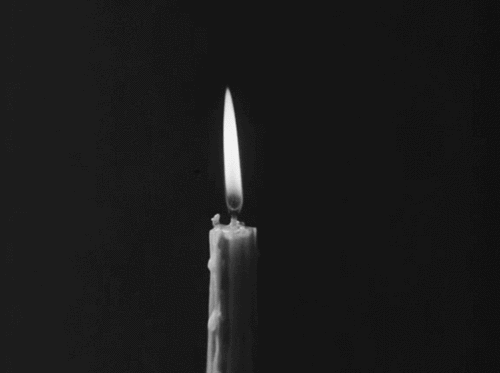

MATTHEW 19:3-12
3 The Pharisees also came to Him, testing Him, and saying to Him, "Is it lawful for a man to divorce his wife for just any reason?" 4 And He answered and said to them, "Have you not read that He who made them at the beginning 'made them male and female,' 5 and said, 'For this reason a man shall leave his father and mother and be joined to his wife, and the two shall become one flesh'? 6 So then, they are no longer two but one flesh. Therefore what God has joined together, let not man separate. 7 They said to Him, "Why then did Moses command to give a certificate of divorce, and to put her away?" 8 He said to them, "Moses, because of the hardness of your hearts, permitted you to divorce your wives, but from the beginning it was not so. 9 And I say to you, whoever divorces his wife, except for sexual immorality, and marries another, commits adultery; and whoever marries her who is divorced commits adultery. 10 His disciples said to Him, "If such is the case of the man with his wife, it is better not to marry." 11 But He said to them, "All cannot accept this saying, but only those to whom it has been given: 12 For there are eunuchs who were born thus from their mother's womb, and there are eunuchs who were made eunuchs by men, and there are eunuchs who have made themselves eunuchs for the kingdom of heaven's sake. He who is able to accept it, let him accept it.
1 CORINTHIANS 1:3-9
3 Grace to you and peace from God our Father and the Lord Jesus Christ. 4 I thank my God always concerning you for the grace of God which was given to you by Christ Jesus, 5 that you were enriched in everything by Him in all utterance and all knowledge, 6 even as the testimony of Christ was confirmed in you, 7 so that you come short in no gift, eagerly waiting for the revelation of our Lord Jesus Christ, 8 who will also confirm you to the end, that you may be blameless in the day of our Lord Jesus Christ. 9 God is faithful, by whom you were called into the fellowship of His Son, Jesus Christ our Lord.
2 notes
·
View notes
Link
If you’ve been to Russia, you may have seen Yaroslavl before, enshrined on the Russian 1000 rouble bill.
If you love art history or religious studies, be sure to stop in Yaroslavl for a vast collection of monasteries, churches, and cathedrals. Whether you’re on a road trip through Russia or on a river cruise be sure to look up some of these fun things to do in Yaroslavl.
1. The Transfiguration Monastery
The Transfiguration Monastery is a UNESCO World Heritage Site that you won’t want to miss. The oldest part of the building dates back to the 16th-century. Stop by to see the stunning architecture and frescos. This is definitely a worthwhile spot for history buffs and art lovers. Climb to the tops of the cathedral’s bell tower for an incredible view of Yaroslavl.
2. Museum Music and Time
If you love music be sure to check out the Museum Music and Time filled with antique instruments and gramophones. In the same museum complex you’ll find a museum dedicated to porcelain and another to samovars, so this is really a good choice for an antique lover. The museum also offers a beautiful concert chamber and boutique hotel.
3. The Residence of Her Majesty the Queen of Maslenitsa
The Residence of Her Majesty the Queen of Maslenitsa is a wooden recreation of the town of Yaroslavl in the year 1913. The Residence is dedicated to a celebration of traditional Russian culture, so this is a great place to stop by for Russian cuisine. This is also a good option for families if you can catch one of their folk performances or plays. If you love fashion, check out some of the most glamorous looks of the time at The Residence of Her Majesty the Queen of Maslenitsa
4. The Cathedral of the Assumption
For those who love architecture, it would be a crime to miss the Cathedral of the Assumption. The stark white cathedral, topped with golden domes cuts an iconic image. While the original cathedral was built in 1215, it was destroyed multiple times, most recently by the Soviets. The building that stands today was built in 2005. The cathedral is located in a park with sculptures and monuments, so be sure to spend some time exploring the park in the warmer months.
5. Yaroslavl Art Museum
Located in the early 19th-century Governor’s Mansion, the Yaroslavl Art Museum is a great place to learn about Russian art from the 18th through the 20th-century. Stop by to appreciate their gorgeous portraits and furniture. If you’re a sucker for reenactments be sure to check out their events.
6. Volga Promenade
For the nature lover, make some time for the Volga Promenade and riverside park. If you’re planning on adding the Volga Promenade to a day of sightseeing, keep in mind that the Promenade is just a few minute’s walk away from the Cathedral of the Assumption and St. Elijah Church. Enjoy an afternoon walk or a shaded jog
7. Volkov Theatre (The Russian State Academic Drama Theatre)
Yaroslavl’s main claim to fame is as the birthplace of the first national professional theatre company in Russia. Although the building that stands today was built in 1911, the theatre company itself was formed in 1750. Today the theatre hosts a youth festival and international festival as well as hosting regular productions of Russian and international classics. For a taste of some of Russia’s finest theatre, be sure to catch a performance while you’re in town.
8. Yaroslavl Zoo
The zoo is a great idea if you’re traveling with a family. This zoo offers a lot of hands on areas where kids can feed the animals and play with smaller ones like rabbits. See zebras, feed goats, and learn about Russian wildlife at the Yaroslavl Zoo.
9. Yaroslavl Architectural, Historical, and Art Museum Preserve
Located in the same compound as the Transfiguration Monastery and the Spassky Monastery, the Architectural, Historical, and Art Museum Preserve can be a convenient addition to your itinerary. The preserve consists of a collection of bell towers, monasteries, and churches. Climb to the top of one of the bell towers for beautiful views of Yaroslavl and the surrounding nature, or if you love art check out their collection of 15th and 16th-century icons.
10. The Bear Monument
The Bear Monument was erected in 2009 to celebrate the 1000th birthday of the town of Yaroslavl. Legend holds that Yaroslavl was founded in 1010 after Yaroslav the Wise killed a bear in the town’s current location. A fun surprise if you’re traveling with kids, every hour the bear roars.
Read also: Top 10 things to do in Terracina, Italy
From : https://wikitopx.com/orther/top-10-things-to-do-in-yaroslavl-russia-708846.html
0 notes
Text
جستجوی بناهای شگفت انگیر در شهرهای اطراف مسکو
پایتخت روسیه غنی از تاریخ و فرهنگ است و جاهای دیدنی بسیاری دارد. در اطراف مسکو نیز بناهای تاریخی و ارزشمند وجود دارد که ارزشش را دارد که برای دیدن آنها زمان بگذارید. همراه با الفبای سفر از این مکانهای حیرت انگیز مطلع شوید.
موزه و عمارت Arkhangelskoye روسیه
شما فقط به یک ساعت زمان احتیاج دارید تا به تماشای یکی از مشهورترین عمارتهای شهر بروید که در نزدیکی مسکو قرار دارد. این بنای خیره کننده به خانوداه Youssoupov تعلق داشت که همچنان نیز جلال و شکوه خود را از دست نداده است. این سازه یکی از زیباترین بناهای است که در حومه مسکو قرار گرفته است که میزبان رویدادهای مختلف از جمله جشنوارهای موسیقی و فستیوال جاز نیز می باشد که در تور مسکو شبهای سفید می توانید در این جشنواره ها حضور داشته باشید.
عمارت Gorki Leninskie روسیه
الفبای سفر شما را با بهترین مکانهای دیدنی اطراف مسکو آشنا می کند که به دوران شوروی سابق تعلق دارند. بنابراین به لیست جاهای دیدنی روسیه که مربوط به شوروی سابق است این بنا را اضافه کنید. این بنا مانند آرامگاه لنین یک مکان مقدس است که مربوط به رهبر مشهور اتحاد جماهیر شوروی والادیمیر لنین می باشد.
در عمارت Gorki Leninskie می توانید چندین مجسمه لنین و آثار تاریخی شوروی سابق و خانه ایی که لنین در آن زندگی کرده را در تور مسکو سن پترزبورگ ببینید. در این محل همچنین میتوانید 3 موزه کشف کنید: موزه لنین؛ موزه Lenin’s Kremlin Cabinet و موزه Peasant Life Museum.( برای رزرو هتلهای روسیه با الفبای سفر همراه باشید).
موزه یاروسلاول Yaroslavl روسیه
یکی از محبوب ترین و پربازدیدترین بناهای حلقه طلایی روسیه(حلقه طلایی روسیه به شهرهای شمال شرقی مسکو گفته میشود که مملو از کلیسا و آثار تاریخی است) یعنی شهر یاروسلاول؛ موزه یاروسلاول است.این موزه دارای 800 سال قدمت است که معماریی بسیار باشکوهی دارد. برای تماشای این بنا بهتر است که وقت بیشتری بگذارید.
اگر با تور یک روزه به این محل به گشت و گذار می پردازید بهترین کار این است که در کنار طولانی ترین رودخانه اورپا ولگا پیاده روی کنید و از کلیساهای قرن 11 نیز که بخشی از زیباییهای این شهر است در تور مسکو خرداد 98 دیدن کنید. همچنین می توانید از یک مجموعه قابل توجه موزه Governor’s House نیز دیدن کنید. در این موزه مجموعه از اشیایی عتیقه، گرامافونهای قدیمی و ساعتهای مختلف نگهداری می شوند.
موزه Sergiyev Posad روسیه
یکی از شهرهایی که در نزدیکی مسکو و در مسیر حلقه طلایی شهر های باستانی گنجانده شده است شهر Sergiyev Posad است که قلب ارتدوکس روسیه است. در اینجا شما می توانید یکی از بزرگترین صومعه های ارتدوکس جهان را مشاهده کنید یعنی صومعه Sergieva Lavra. این صومعه در قرن 14 تاسیس شده و شامل یک کلیسای جامع و 8 کلیسای کوچک است. این شهر کوچک همچنین دارای چند موزه مهم دیگر نیز است از جمله مجموعه موزه Konniy Dvor، موزه اسباب بازی و موزه صابون که در تور روسیه شبهای سفید می توانید از آنها دیدن کنید.
موزه های شهر روستوف ولیکی Rostov Veliky روسیه
یکی دیگر از جاهایی که نباید بازدید آن را از دست بدهید شهر رستوف ولیکی است که در نزدیکی مسکو قرار دارد. این شهر یکی از قدیمی ترین شهرهای روسیه با تاریخ غنی، طبیعت حیرت انگیز و غذاهای خوشمزه است.مانند دریاچه نرو، صومعه ها و کلیساهای باستانی و امتحان کردن غذاهای لذیذ در تور ترکیبی روسیه در رستوران Lukova Slobod.
آثار تاریخی شهر والادیمر Vladimir روسیه
والادیمر یکی دیگر از شهرهای زیبای باستانی روسیه است با کلیساهای باشکوه ارتدوکس و معماری سنتی با بنای سنگ سفید که بسیار حیرت انگیز هستند. جاذبه های دیدنی زیادی در این شهر وجود دارد از جمله دروازه طلایی که نشان دهنده ورود به شهر قدیمی است، کلیسای تثلیث مقدس قدیمی که درست در پشت آن قرار دارد و کلیسای جامع Saint Demetrius . اگر هم شما برای خرید سوغات برنامه ریزی کردید از موزه نان زنجبیلی یا موزه کریستال و مینیاتور می توانید دیدن و یا خرید کنید. قبل از شروع سفر خود بلیط هواپیما مسکو را تهیه کنید.
بناهای قدیمی شهر سوزدال Suzdal روسیه
با نیم ساعت فاصله با خودرو از والادیمر به شهر سوزدال خواهید رسید. این شهر کوچک دارای تعدادی کلیسا و 5 صومعه مانند صومعه Spaso-Yevfimiev می باشد. همچنین خانه های قدیمی روستایی در سراسر شهر سوزدال را این منطقه می توانید کشف کنید.برای خرید سوغات نیز می توانید به بازار Torgovaya ploshchad بروید جایی که می توانید در آن در ��ور سن پتربورگ بهار 98، عسل، قارچ، انواع توت و یا سوغات تهیه کنید.
#تور مسکو#تور ارزان مسکو#تور لحظه آخری مسکو#تور مسکو شب های سفید#تور مسکو بهار 98#تور مسکو تابستان 98
0 notes
Text
جستجوی بناهای شگفت انگیر در شهرهای اطراف مسکو
پایتخت روسیه غنی از تاریخ و فرهنگ است و جاهای دیدنی بسیاری دارد. در اطراف مسکو نیز بناهای تاریخی و ارزشمند وجود دارد که ارزشش را دارد که برای دیدن آنها زمان بگذارید. همراه با الفبای سفر از این مکانهای حیرت انگیز مطلع شوید.
موزه و عمارت Arkhangelskoye روسیه
شما فقط به یک ساعت زمان احتیاج دارید تا به تماشای یکی از مشهورترین عمارتهای شهر بروید که در نزدیکی مسکو قرار دارد. این بنای خیره کننده به خانوداه Youssoupov تعلق داشت که همچنان نیز جلال و شکوه خود را از دست نداده است. این سازه یکی از زیباترین بناهای است که در حومه مسکو قرار گرفته است که میزبان رویدادهای مختلف از جمله جشنوارهای موسیقی و فستیوال جاز نیز می باشد که در تور مسکو شبهای سفید می توانید در این جشنواره ها حضور داشته باشید.
عمارت Gorki Leninskie روسیه
الفبای سفر شما را با بهترین مکانهای دیدنی اطراف مسکو آشنا می کند که به دوران شوروی سابق تعلق دارند. بنابراین به لیست جاهای دیدنی روسیه که مربوط به شوروی سابق است این بنا را اضافه کنید. این بنا مانند آرامگاه لنین یک مکان مقدس است که مربوط به رهبر مشهور اتحاد جماهیر شوروی والادیمیر لنین می باشد.
در عمارت Gorki Leninskie می توانید چندین مجسمه لنین و آثار تاریخی شوروی سابق و خانه ایی که لنین در آن زندگی کرده را در تور مسکو سن پترزبورگ ببینید. در این محل همچنین میتوانید 3 موزه کشف کنید: موزه لنین؛ موزه Lenin’s Kremlin Cabinet و موزه Peasant Life Museum.( برای رزرو هتلهای روسیه با الفبای سفر همراه باشید).
موزه یاروسلاول Yaroslavl روسیه
یکی از محبوب ترین و پربازدیدترین بناهای حلقه طلایی روسیه(حلقه طلایی روسیه به شهرهای شمال شرقی مسکو گفته میشود که مملو از کلیسا و آثار تاریخی است) یعنی شهر یاروسلاول؛ موزه یاروسلاول است.این موزه دارای 800 سال قدمت است که معماریی بسیار باشکوهی دارد. برای تماشای این بنا بهتر است که وقت بیشتری بگذارید.
اگر با تور یک روزه به این محل به گشت و گذار می پردازید بهترین کار این است که در کنار طولانی ترین رودخانه اورپا ولگا پیاده روی کنید و از کلیساهای قرن 11 نیز که بخشی از زیباییهای این شهر است در تور مسکو خرداد 98 دیدن کنید. همچنین می توانید از یک مجموعه قابل توجه موزه Governor’s House نیز دیدن کنید. در این موزه مجموعه از اشیایی عتیقه، گرامافونهای قدیمی و ساعتهای مختلف نگهداری می شوند.
موزه Sergiyev Posad روسیه
یکی از شهرهایی که در نزدیکی مسکو و در مسیر حلقه طلایی شهر های باستانی گنجانده شده است شهر Sergiyev Posad است که قلب ارتدوکس روسیه است. در اینجا شما می توانید یکی از بزرگترین صومعه های ارتدوکس جهان را مشاهده کنید یعنی صومعه Sergieva Lavra. این صومعه در قرن 14 تاسیس شده و شامل یک کلیسای جامع و 8 کلیسای کوچک است. این شهر کوچک همچنین دارای چند موزه مهم دیگر نیز است از جمله مجموعه موزه Konniy Dvor، موزه اسباب بازی و موزه صابون که در تور روسیه شبهای سفید می توانید از آنها دیدن کنید.
موزه های شهر روستوف ولیکی Rostov Veliky روسیه
یکی دیگر از جاهایی که نباید بازدید آن را از دست بدهید شهر رستوف ولیکی است که در نزدیکی مسکو قرار دارد. این شهر یکی از قدیمی ترین شهرهای روسیه با تاریخ غنی، طبیعت حیرت انگیز و غذاهای خوشمزه است.مانند دریاچه نرو، صومعه ها و کلیساهای باستانی و امتحان کردن غذاهای لذیذ در تور ترکیبی روسیه در رستوران Lukova Slobod.
آثار تاریخی شهر والادیمر Vladimir روسیه
والادیمر یکی دیگر از شهرهای زیبای باستانی روسیه است با کلیساهای باشکوه ارتدوکس و معماری سنتی با بنای سنگ سفید که بسیار حیرت انگیز هستند. جاذبه های دیدنی زیادی در این شهر وجود دارد از جمله دروازه طلایی که نشان دهنده ورود به شهر قدیمی است، کلیسای تثلیث مقدس قدیمی که درست در پشت آن قرار دارد و کلیسای جامع Saint Demetrius . اگر هم شما برای خرید سوغات برنامه ریزی کردید از موزه نان زنجبیلی یا موزه کریستال و مینیاتور می توانید دیدن و یا خرید کنید. قبل از شروع سفر خود بلیط هواپیما مسکو را تهیه کنید.
بناهای قدیمی شهر سوزدال Suzdal روسیه
با نیم ساعت فاصله با خودرو از والادیمر به شهر سوزدال خواهید رسید. این شهر کوچک دارای تعدادی کلیسا و 5 صومعه مانند صومعه Spaso-Yevfimiev می باشد. همچنین خانه های قدیمی روستایی در سراسر شهر سوزدال را این منطقه می توانید کشف کنید.برای خرید سوغات نیز می توانید به بازار Torgovaya ploshchad بروید جایی که می توانید در آن در تور سن پتربورگ بهار 98، عسل، قارچ، انواع توت و یا سوغات تهیه کنید.
0 notes
Photo
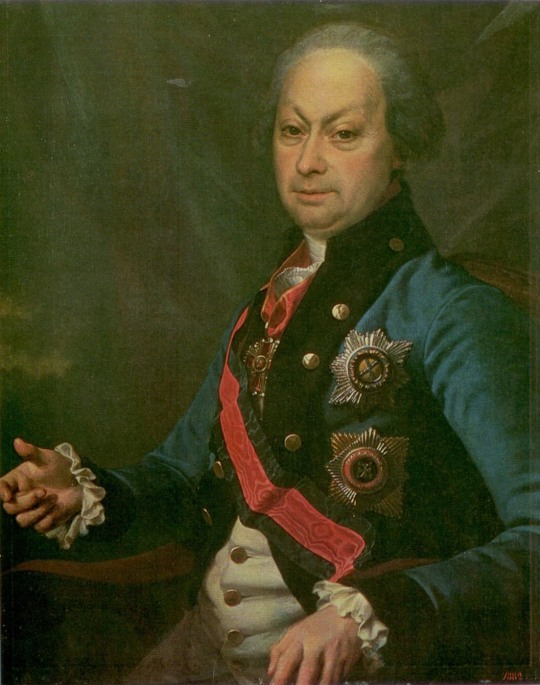
Melgunov, Alexei Petrovich, Governor-General Yaroslavl and Vologda, 1795, Dmitry Levitzky
Medium: oil,canvas
7 notes
·
View notes
Photo

On a bridge to the Kremlin. The sign says : "Boris Nemtsov was murdered here on 27 February 2015. Organizers and masterminds of the crime could not be found. Who was Birus Nemtsov? -a talented physicist -the Governor of the Nizhny Novgorod region (1990-1997) -The Vice-Premier if Russia (1997-1998) -The member of Yaroslavl Duma (2013-2015) -A prominent opposition leader” (at Moscow, Russia) https://www.instagram.com/p/BpitQRhFyf1/?utm_source=ig_tumblr_share&igshid=dtcdsx1gfgls
0 notes
Text
The boat we are on has been refurbished but still shows its age. The staff are definitely Russian with a very yes no mentality. They are not bad just very direct and focused on what is their job and what is not. The only complaint we plus most other passengers is the breakfast food. They keep trying to give us vegetables. Haha The cruise is well timed as far as planning for the on shore activities and there has been lots of them. On Monday we visited the Monastery of St Cyril of the White Lake which has so many stories from its past along with the worlds largest collection of "Icons". This is where the Tsars would send troublesome wives and children at times. In one instance a new born child for life. We have also been watching the series on the Tsars through the generations and they were so cruel at times and such great leaders at other times. Ivan the Terrible the cruelest, even killing his own son because he did not like what his wife was wearing. Peter the Great a true leader who was responsible for bringing Russia into the modern age. Catherine the Great probably achieved the most though in leading the country by playing politics to become a real power in Europe. Tuesday was great when we visited the city of Yaroslavl where we saw a former governors residence, entertained in the great ballroom along with more church's. Hahha. A walk through the town saw us do a little power shopping and a visit to the local lookout where the worlds biggest bear is. Not to worry it is a flower garden. We had another theme night on the cruise but the cruise director forgot to tell passengers ahead of time so the crew were the only ones who were dressed up. Wednesday is a very early day with the fog horns blaring just after 5:30am as we were docking on Uglich. This city is small but interesting with more church's of course. The markets here are the best we have been through so some real shopping taking place. Hahah From here we travel through six locks over night. The locks become a little bit like church's after a while. Seen so many but each is different. The daily on board newspaper suggests that the first is the most picturesque so I guess we will have to do the tourist thing and go up to the top deck to get the best photo. Haha The cruise is fast coming to an end which will be sad but we have really enjoyed seeing Russia. Looking forward to Moscow where we will spend three nights.
0 notes